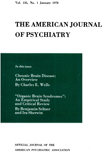Abstract
This series of 110 patients represents a fairly unusual collection of patients from several considerations. They are largely patients in whom previous forms of therapy have not been effective and who have not developed spontaneous remission. It was our feeling that any improvement gained through electronarcosis therapy represented a hitherto unrealized salvage of mental health and probably a preventive of many patient-days of chronic illness. Although this is a small series that will not bear statistical analysis adequately, we feel that the results justify, and in some cases require, the use of electronarcosis treatment in the mechanical treatment of psychiatrically ill people. From our data we believe that patients with anxiety neuroses of 18 months' duration, under 30 years of age, who have not responded to other forms of treatment, should receive electronarcosis. Neurotic depressions and mixed psychoneuroses are also considered good candidates for electronarcosis.
Although many physicians are turning to psychosurgery after electroshock failures with schizophrenia of 2 years' duration, when patients present affective lability, our experience leads us to feel that electronarcosis offers hope to some of these cases and deserves a trial.
The involutional psychoses, particularly with agitation and/or melancholia, should be treated with electronarcosis when electroshock fails. The conclusion seems justified that this step should be taken before performing psychosurgery.
Because of the uniformly poor results with other forms of mechanical treatment of the psychopathic personality we feel that this disorder should be given the opportunity to benefit from electronarcosis. No particular advantage from electronarcosis was found in manic-depressive psychoses, neurasthenia, or obsessive-compulsive ruminative tension states.
Safety of electronarcosis therapy is reflected in the fact that no deaths directly attributable to electronarcosis and relatively few serious complications occurred in the series. There were no orthopaedic complications in the 110 cases. It should be pointed out again that one of the indications for electronarcosis in. this series was poor physical risk for other forms of mechanical therapy.
The advantages of electronarcosis are many. Postshock confusion is relatively little, and therefore more freedom for the patient is possible. Concomitant psychotherapy is made possible, as well as more accurate evaluation of the status of the disorder during treatment. From the patient's standpoint electronarcosis is obviously less objectionable than electroshock.
The disadvantages of electronarcosis as compared to electroshock are apparent. Electronarcosis is time-consuming, fairly exacting, and demands highly trained personnel. It does not seem likely, or even desirable, that electronarcosis should replace the tried and proved mechanical treatment methods. It is, however, a valuable adjunct to the established therapies in our efforts to provide total treatment for our patients.

